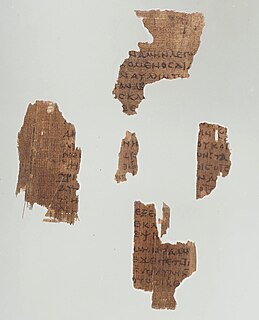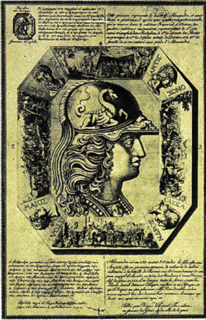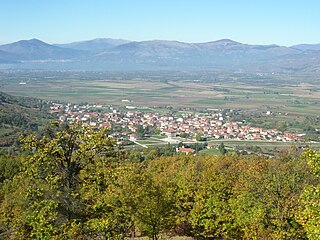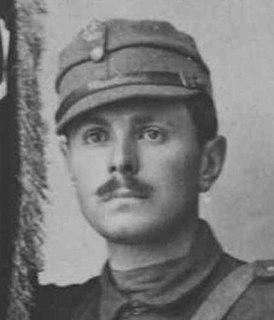
The "Hymn to Liberty", or "Hymn to Freedom", is a poem written by Dionysios Solomos in 1823 that consists of 158 stanzas and is used as the national anthem of Greece and Cyprus. It was set to music by Nikolaos Mantzaros in 1865 and is the longest national anthem in the world by length of text. It officially became the national anthem of Greece in 1865 and Cyprus in 1966.

The League of Corinth, also referred to as the Hellenic League, was a confederation of Greek states created by Philip II in 338–337 BC. The League was created in order to unify Greek military forces under Macedonian leadership (hegemony) in their combined conquest of Persia.

The Battle of Vevi, in Greece, also known as the Battle of the Klidi Pass, was part of the Greek campaign of World War II. It took place on 11–12 April 1941, north of the town of Amyntaion, close to the northwestern Greek border. Allied troops fought forces from Nazi Germany.
Maro Douka is a Greek novelist. She has lived in Athens since 1966 and she studied History and Archaeology at the University of Athens. She belongs to the so-called Genia tou 70, which is a literary term referring to Greek authors who began publishing their work during the 1970s; her debut work, Η Πηγάδα, based on her imprisonment in 1967 by the Military Junta, was published in 1974, just a few months after the Metapolitefsi.

Codex Boreelianus, Codex Boreelianus Rheno-Trajectinus, designated by Fe or 09 in the Gregory-Aland numbering and ε 86 in von Soden numbering, is a 9th century uncial manuscript of the four Gospels in Greek. The manuscript, written on parchment, is full of lacunae, many of which arose between 1751 and 1830. The codex was named Boreelianus after Johannes Boreel (1577–1629), who brought it from the East.

Papyrus 6, designated by 𝔓6 or by ε 021, is a fragmentary early copy of the New Testament in Greek and Coptic (Akhmimic). It is a papyrus manuscript of the Gospel of John that has been dated paleographically to the 4th century. The manuscript also contains text of the First Epistle of Clement, which is treated as a canonical book of the New Testament by the Coptic Church. The major part of the codex is lost.

Theodore Kavalliotis was a Greek Orthodox priest, teacher and a figure of the Greek Enlightenment. He is also known for having drafted an Aromanian–Greek–Albanian dictionary.

The Battle of the Metaxas Line, also known in Greece as the Battle of the Forts, was the first battle during the German invasion of Greece in World War II. The Germans succeeded in capturing several individual forts but failed to breach the fortified Metaxas Line in general. The 2nd Panzer division with an enveloping move crossed the Yugoslavian borders, overcame Yugoslav and Greek resistance and captured Thessaloniki on the 9th of April. The capture of Thessaloniki forced the Greek East Macedonia Army Section to surrender on the 10th of April and the Metaxas Line battle was over.

The Battle of Kleisoura Pass took place from the evening of 13 April 1941, when first contact was made, until the midday of 14 April, when Greek organized resistance collapsed. The battle was fought over the narrow pass that crosses between Mt. Vitsi and Mt. Siniatsiko, between elements of the Greek 20th Infantry Division which were occupying the pass and the German Leibstandarte SS Adolf Hitler, a mechanized infantry unit of brigade level. The pass was strategically important for it stood on the main Allied defensive line, behind which passed the withdrawal route of the Greek army engaged against the Italians in Albania.
The 20th Infantry Division was a short-lived formation of the Hellenic Army. It was founded on 24 January 1941, when Greece was already embroiled in the Greco-Italian War.

The Pamphlet of Rigas Feraios is a large chalcography printed in Vienna in 1797 by Rigas Feraios. It depicts a portrait of Alexander the Great framed by war scenes and portraits of his generals. The etching was incised by François Müller, who cooperated with Rigas for his cartographic work which he published the same year: Rigas' Map of Greece (1797), the New Map of Wallachia (1797) and the General Map of Moldavia (1797). It was released in 1200 copies from the printing press of Nitsch. One of the two copies that have been discovered in Greece is displayed in the National Historical Museum of Greece.

The General Map of Moldavia is one of the two maps of the Danubian Principalities which was printed by Rigas Feraios in 1797, the other being the New Map of Wallachia. He printed it in Jacob Nits’ printing press and the engraving was made by Franz Müller. The map is of 82 x 63 cm. in black and white and it is printed on paper from Holland. Its full title is "GENERAL MAP / OF / MOLDAVIA,/ AND PART OF ITS NEIGHBOR PROVINCES/. Published by Rigas Velestinlis from Thessaly for the sake of Greeks and philhellenes, 1797. Engraved by Francois Müller in Vienna".

The Dodecanese Regiment or Regiment of the Dodecanesians was an infantry regiment of the Hellenic Army composed to a large extent of volunteers from the Dodecanese Islands and was formed shortly after Greece entered World War II. The islands were under Italian occupation since 1912, and consequently the Dodecanesian Greeks had Italian citizenship, yet they were eager to fight against the Italian Army either in the Dodecanese or on the Albanian Front.

The Battle of Lake Kastoria consisted of two parallel engagements north and south of Lake Kastoria between Greek and German forces on 15 April 1941. Following the Greek failure to hold the Pass of Kleisoura on 14 April a new attempt was made to stop the German advance east of the road Bilisht – Kastoria – Grevena, which was used as the main route for the withdrawal of the Greek Western Macedonia Army Section.

The celebration of the Greek Revolution of 1821, less commonly known as Independence Day, takes place in Greece, Cyprus and Greek diaspora centers on 25 March every year, coinciding with the Feast of the Annunciation.
Konstantinos A. Dimadis is a Greek scholar and emeritus professor in Modern Greek studies at the Freie Universität Berlin.
Major General (Generalmajor) Franz Krech was the German commander of the 41st Fortress Division of the Wehrmacht during the World War II Axis occupation of Greece. He was ambushed and killed by a platoon of the Greek People's Liberation Army (ELAS) in Laconia. It led to harsh reprisals by the occupying forces and contributed to the declaration of the Peloponnese as an "operational zone", i.e. a war zone.
The Malathyros executions refer to the mass execution by firing squad of 61 male civilians from the village of Malathyros in Crete, Greece by German forces on 28 August 1944 during World War II.

Stamatis Stamatiou was a Greek journalist, author, cartoonist and politician. As a journalist and author he is more widely known with his initials "Stam. Stam.", his usual signature. He served as prefect in prefectures of Macedonia and Crete.














